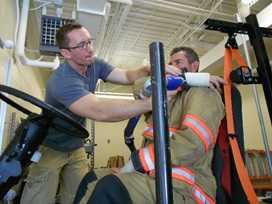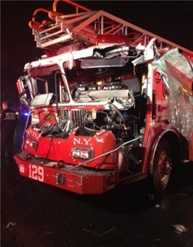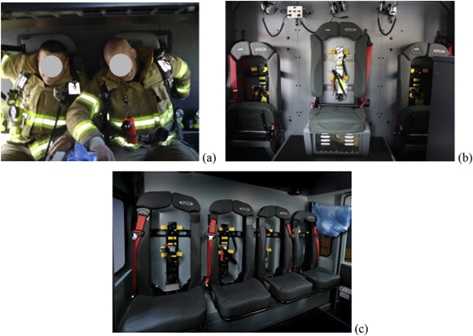NIOSH Firefighter Body Dimension Data Supports Design Changes and Safety
December 2, 2015
NIOSH Update:
Contact: Nura Sadeghpour (202) 245-0673

NIOSH Division of Safety Research branch chief, Hongwei Hsiao, in the full body scanner in the Morgantown, WV Anthropometry Lab. The full body scanner is used to collect highly accurate body dimension information and produces high resolution scans within seconds.
We have come to rely on, and expect firefighters to rush into burning buildings, put out flames, and save lives. Yet, each year many firefighters die in the line of duty and thousands more sustain injuries. For these reasons, researchers at the National Institute for Occupational Safety and Health (NIOSH) recorded and developed the first database of firefighter body measurements (also known as anthropometric information) to improve the design, and ultimately the safety, of fire apparatus and equipment that firefighters depend on to help protect themselves on the job.
Just imagine the threats firefighters face when they are not able to fasten their seatbelts quickly, or at all, in a fast-moving fire truck. When approximately 100 firefighters die in the U.S. per year and about 72,000 sustain injuries, this begs the question: how do we keep firefighters safer on the job, whether they are on the way to the scene of a fire or engaged in putting one out?
Keeping firefighters safe requires collaboration among industry leaders. That’s why over the past 6 years NIOSH has worked with the firefighter community, firefighter apparatus manufacturers, and the National Fire Protection Association (NFPA) standards committee to conduct the first national survey of firefighter body dimension information. The survey included 951 male and female firefighters from across the United States.
“Before our research, the majority of body dimension data available was from military personnel collected several decades ago, which does not accurately represent today’s workers who are much more diverse in age, gender, and ethnicity,” said Dr. Hongwei Hsiao, principal investigator and branch chief for the Division of Safety Research at NIOSH. “We also know that workers have unique sizes and shapes that vary by occupation.”

An assistant digitizes a firefighter study participant’s wrist location using a Faro Arm device, while the participant reaches for his seatbelt in turnout gear.
In total, 71 body dimension measurements were collected, using both 3-dimensional scanning technologies and traditional digitization methods, as part of the survey. The data collected contributed to the development of the first database to aid fire apparatus and equipment manufacturers in updating the designs of their seat belts, fire truck cabs, gloves, boots, seats, and self-contained breathing apparatus carrying straps, and protective clothing.
To date, the database has been shared with 17 firefighter associations and firefighter apparatus manufacturers as well as a number of fire service partners to help them make informed decisions about the apparatus and equipment they use to respond to a fire event. Now the data is available to the public on the NIOSH website.
In addition to the database, NIOSH developed and tested a series of design procedures, which provide the basis for equipment designers, standards writers, and industry manufacturers to use and improve firefighter equipment design and efficacy. Findings from the design procedures suggest that changes to fire apparatus and personal protective equipment are needed to accommodate today’s diverse workforce of firefighters.
“The data obtained in this survey provide the first available U.S. national firefighter anthropometric information needed for updating ergonomic and safety specifications for fire apparatus and firefighter protective equipment,” said NIOSH Director John Howard, M.D. “We know that design changes to fire apparatus and protective equipment, based on the data we collected, can keep firefighters safe whether they are on their way to the scene of a fire or in the line of duty.”
Key findings from the database of body dimension measurements and design procedures include:
- Firefighters have different body sizes than the U.S. population: On average, male firefighters were taller and had larger upper-body builds than the general U.S. population.
- PPE fit can compromise performance: About 1 in 4 men and 1 in 2 women reported problems with the fit or bulkiness of structural firefighting gloves.
- Fire apparatus design changes can improve safety: Data show that firefighters in turnout gear do not fit well in today’s fire apparatus, which has implications for safety.

The new seatbelt design was installed in this fire apparatus, which likely saved the lives of firefighters when it crashed.
Previous research demonstrated that some firefighters are not able to buckle their seatbelt in emergency vehicles when wearing turnout gear. As a result of NIOSH’s database, a large, metropolitan fire department retrofitted older fire apparatus with a new seatbelt system. This system aligns with a new NFPA specification for seatbelt length, configuration, and retraction.
“We’re delighted that the data is being used to support design changes and look forward to possible future changes to reduce the risk of injury and death among firefighters,” said Dr. Hsiao.
NIOSH provided data regarding safety issues with seating not adequately fitting firefighters in turnout gear and head supports to reduce neck injuries in rear-impact crashes to the NFPA Technical Committee on Fire Apparatus for consideration.
For more information on firefighter anthropometric research, please visit our Featured Engineering Publications page. For general information about workers’ physical measures, please visit our Anthropometry topic page.

Image “a” shows the challenge that firefighters have sitting in a row in their turnout gear. Images “b” and “c” show three and four-forward facing crew seats (22’’ wide) along the rear wall of the fire cab, respectively. The seats shown are in current fire trucks. Enlarging the seats from 22’’ to 28.9’’ would allow for three seats and enable firefighters to fasten seatbelts easier in turnout gear. This is a practical and cost-reasonable solution for seats along the rear wall.
For more information, see the complete article in Applied Ergonomics.
NIOSH’s Division of Safety Research is the focal point for traumatic injury research. Using a public health approach the Division’s research involves: injury data collection and analysis, field investigations, analytic epidemiology, protective technology, and safety engineering. For more information visit: http://www.cdc.gov/niosh/contact/im-dsr.html.
NIOSH is the federal agency that conducts research and makes recommendations for preventing work-related injuries, illnesses, and deaths. More information about NIOSH can be found at: http://www.cdc.gov/niosh/
- Page last reviewed: December 2, 2015
- Page last updated: December 2, 2015
- Content source:
- National Institute for Occupational Safety and Health Education and Information Division


 ShareCompartir
ShareCompartir